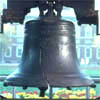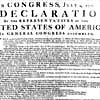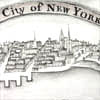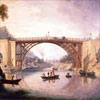 Text search Text search
 Related images Related images
 HistoryWorld HistoryWorld
 Link Link
 Map Map
Click the icons to visit linked content. Hover to see the search terms |
|  |
| | | | World History timeline |
| | | | | | |
| 1776 |
| | | George Washington drives the British garrison from Boston, and moves south to protect New York | |  
| |
|
| 1776 |
| | | The revolutionary convention of Virginia votes for independence from Britain, and instructs its delegates in Philadelphia to propose this motion | | 
| |
|
| 1776 |
| | | Virginia's motion for independence from Britain is passed at the Continental Congress of the colonies with no opposing vote | |  
|  | Liberty Bell, Philadelphia
Fotofile CG
|
|
|
| 1776 |
| | | Thomas Jefferson's text for the Declaration of Independence is accepted by the Congress in Philadelphia | |   
| |
|
| 1776 |
| | | English historian Edward Gibbon publishes the first volume of The Decline and Fall of the Roman Empire | |   
| |
|
| 1776 |
| | | John Hancock is the first delegate to sign the Declaration of Independence, formally written out on a large sheet of parchment | |   
|  | The American Declaration of Independence in 1776
National Archives, Kew
|
|
|
| 1776 |
| | | George Washington, driven from New York by the British, retreats towards Philadelphia | |  
|  | Map of New York in 1765
National Archives, Kew
|
|
|
| 1776 |
| | | Spanish America is now administered as four viceroyalties - New Spain, New Granada, New Peru and La Plata | | 
| |
|
| 1776 |
| | | Buenos Aires rather than Asunción is chosen to be capital of the new Spanish viceroyalty of La Plata | | 
| |
|
| 1776 |
| | | Scottish economist Adam Smith analyzes the nature and causes of the Wealth of Nations | |   
| |
|
| 1776 |
| | | George Washington defeats the British at Trenton at a psychologically important moment in the course of the war | |  
| |
|
| 1777 |
| | | Congress adopts a new flag for independent America – the stars and stripes | |  
| |
|
| 1777 |
| | | George Washington, heavily defeated in a battle at Brandywine, is forced to relinquish Philadelphia to the British | |  
| |
|
| 1777 |
| | | Richard Brinsley Sheridan's second play, The School for Scandal, is an immediate success in London's Drury Lane theatre | |   
| |
|
| 1777 |
| | | The American general Horatio Gates captures the army of General Burgoyne near Saratoga | |   
| |
|
| 1777 |
| | | The US Congress agrees the final version of the Articles of Confederation, defining the terms on which states join the Union | |  
| |
|
| 1778 |
| | | Benjamin Franklin persuades the French to sign a Treaty of Alliance, committing France to the US cause | |   
| |
|
| 1778 |
| | | France, joining the American colonies in their fight against Britain, sends a large fleet across the Atlantic | | 
| |
|
| 1778 |
| | | The American naval hero John Paul Jones makes successful raids around the coasts of Britain | |  
| |
|
| 1778 |
| | | In Brook Watson and the Shark John Singleton Copley creates the most intensely dramatic of his modern history paintings | |   
| |
|
| 1778 |
| | | The British rapidly abandon Philadelphia on news of the expected arrival of a French fleet | | 
| |
|
| 1778 |
| | | The British adopt a new policy in the south, landing in Georgia and capturing much of South Carolina | | 
| |
|
| 1778 |
| | | Francis Hopkinson's popular ballad The Battle of the Kegs describes an ingenious American threat to the British navy | |   
| |
|
| 1778 |
| | | 15-year-old Elisabeth-Louise Vigée-Lebrun earns enough from painting portraits to support the rest of her family | | 
| |
|
| 1779 |
| | | British explorer Captain James Cook is killed in a skirmish with natives in Hawaii over a stolen boat | |  
| |
|
| 1779 |
| | | Joseph Banks tells a committee of the House of Commons that the east coast of Australia is suitable for the transportation of convicted felons | |   
| |
|
| 1779 |
| | | The world's first iron bridge is assembled in a few months across the Severn at Coalbrookdale | |  
|  | W. Williams, The Ironbridge, Coalbrookdale
Ironbridge Gorge Museum
|
|
|
| 1779 |
| | | Samuel Crompton perfects the mule, a machine for spinning that combines the merits of Hargreave's jenny and Arkwright's water frame | |    
| |
|
| 1779 |
| | | The 10-year-old Napoleon is admitted as a student in a military college at Brienne, near Troyes | |   
| |
|
| 1779 |
| | | U.S.S. Bonhomme Richard, commanded by John Paul Jones, fights H.M.S. Serapis near England's Flamborough Head | |    
| |
|
| | | | |